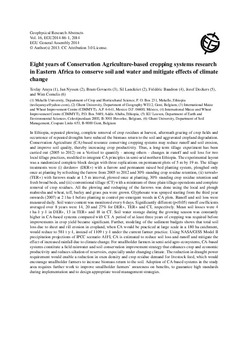Mostrar el registro sencillo del ítem
Eight years of Conservation Agriculture-based cropping systems research in Eastern Africa to conserve soil and water and mitigate effects of climate change
| Autor: | Araya, T. |
| Autor: | Nyssen, J. |
| Autor: | Govaerts, B. |
| Autor: | Lanckriet, S. |
| Autor: | Baudron, F. |
| Autor: | Deckers, J. |
| Autor: | Cornelis, W. |
| Año: | 2014 |
| ISSN: | 1607-7962 |
| URI: | https://hdl.handle.net/10883/19779 |
| URI: | https://biblio.ugent.be/publication/4419456 |
| Resumen: | In Ethiopia, repeated plowing, complete removal of crop residues at harvest, aftermath grazing of crop fields and occurrence of repeated droughts have reduced the biomass return to the soil and aggravated cropland degradation. Conservation Agriculture (CA)-based resource conserving cropping systems may reduce runoff and soil erosion, and improve soil quality, thereby increasing crop productivity. Thus, a long-term tillage experiment has been carried out (2005 to 2012) on a Vertisol to quantify - among others - changes in runoff and soil loss for two local tillage practices, modified to integrate CA principles in semi-arid northern Ethiopia. The experimental layout was a randomized complete block design with three replications on permanent plots of 5 m by 19 m. The tillage treatments were (i) derdero+ (DER+) with a furrow and permanent raised bed planting system, ploughed only once at planting by refreshing the furrow from 2005 to 2012 and 30% standing crop residue retention, (ii) terwah+ (TER+) with furrows made at 1.5 m interval, plowed once at planting, 30% standing crop residue retention and fresh broad beds, and (iii) conventional tillage (CT) with a minimum of three plain tillage operations and complete removal of crop residues. All the plowing and reshaping of the furrows was done using the local ard plough mahresha and wheat, teff, barley and grass pea were grown. Glyphosate was sprayed starting from the third year onwards (2007) at 2 l ha-1 before planting to control pre-emergent weeds in CA plots. Runoff and soil loss were measured daily. Soil water content was monitored every 6 days. Significantly different (p<0.05) runoff coefficients averaged over 8 years were 14, 20 and 27% for DER+, TER+ and CT, respectively. Mean soil losses were 4 t ha-1 y-1 in DER+, 13 in TER+ and 18 in CT. Soil water storage during the growing season was constantly higher in CA-based systems compared with CT. A period of at least three years of cropping was required before improvements in crop yield became significant. Further, modeling of the sediment budgets shows that total soil loss due to sheet and rill erosion in cropland, when CA would be practiced at large scale in a 180 ha catchment, would reduce to 581 t y-1, instead of 1109 t y-1 under the current farmer practice. Using NASA/GISS Model II precipitation projections of IPCC scenario A1FI, CA is estimated to reduce soil loss and runoff and mitigate the effect of increased rainfall due to climate change. For smallholder farmers in semi-arid agro-ecosystems, CA-based systems constitute a field rainwater and soil conservation improvement strategy that enhances crop and economic productivity and reduces siltation of reservoirs, especially under changing climate. The reduction in draught power requirement would enable a reduction in oxen density and crop residue demand for livestock feed, which would encourage smallholder farmers to increase biomass return to the soil. Adoption of CA-based systems in the study area requires further work to improve smallholder farmers' awareness on benefits, to guarantee high standards during implementation and to design appropriate weed management strategies. |
| Formato: | |
| Lenguaje: | English |
| Editor: | European Geosciences Union (EGU). |
| Copyright: | CIMMYT manages Intellectual Assets as International Public Goods. The user is free to download, print, store and share this work. In case you want to translate or create any other derivative work and share or distribute such translation/derivative work, please contact CIMMYT-Knowledge-Center@cgiar.org indicating the work you want to use and the kind of use you intend; CIMMYT will contact you with the suitable license for that purpose. |
| Tipo: | Conference Paper |
| País de enfoque: | Ethiopia |
| Lugar de publicación: | Germany |
| Volumen: | 16 |
| Agrovoc: | AGRICULTURAL PRACTICES |
| Agrovoc: | DROUGHT |
| Agrovoc: | SOIL LOSS |
| Agrovoc: | CONSERVATION AGRICULTURE |
| Agrovoc: | FILED EXPERIMENTATION |
| Agrovoc: | LEGUMES |
| Agrovoc: | CEREAL CROPS |
| Revista: | Geophysical Research Abstracts |
Ficheros en el ítem
Este ítem aparece en la(s) siguiente(s) colección(ones)
-
Sustainable Intensification
Sustainable intensification agriculture including topics on cropping systems, agronomy, soil, mechanization, precision agriculture, etc.

